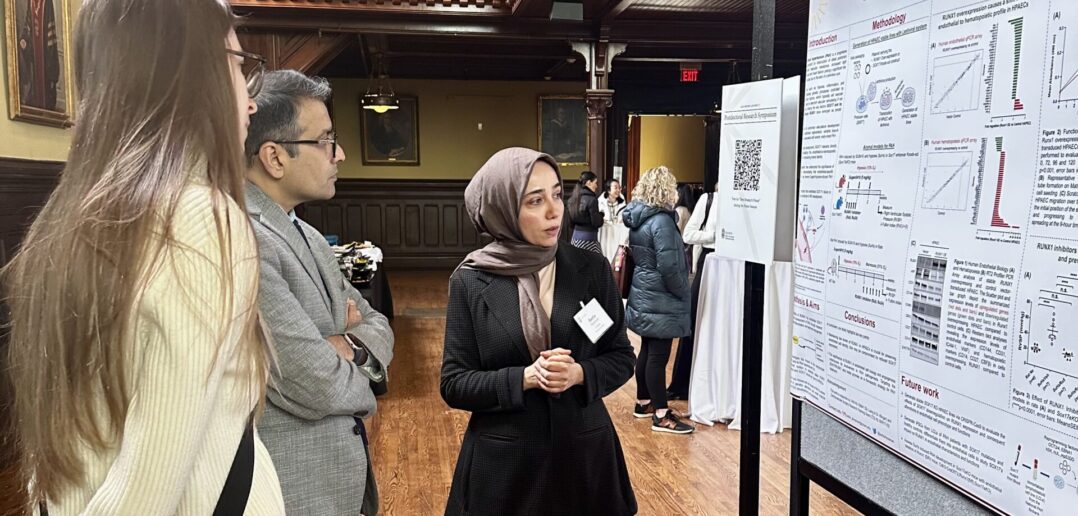Second annual Postdoctoral Research Symposium celebrates Brown’s scholars.
Postdocs in the Division of Biology and Medicine were among those who received top honors on Monday at this year’s Postdoctoral Research Symposium organized by the Office of University Postdoctoral Affairs at Brown.
The symposium honored winners of the Postdoctoral Excellence Awards, which included Caroline Keroack, PhD, a postdoctoral fellow in the Department of Molecular Microbiology and Immunology, who received the Community Award. Beginning last fall, she served as co-president of the Brown Postdoc Council, and has been engaged in the council’s events and meetings. She has also been one of the main drivers for the unionization initiative of the Brown postdoc community.
Keroack presented her research on the metallogenesis in Trypanosoma cruzi, a eukaryotic parasite that is transmitted by kissing bugs and causes Chagas disease. Her research explores genes that define each stage of the parasite as it responds to environmental stimuli, and each stage of metacyclogenesis, which is when the parasite transforms from a noninfective form into one capable of infecting cells. The research lab pioneered a new technology where images of live cells and parasites can be viewed individually as they undergo different changes, which enabled her team to watch metacyclogenesis in real time.
Keroack is interested in finding a compound that can block metacyclogenesis and kill the parasite inside of the kissing bug itself.
“This does not lead to insecticide resistance and will effectively block transmission,” she says. “While that might seem pie in the sky, it’s actually something that is being explored for malaria prevention.”
This research is particularly important for the nearly 75 million people living in endemic areas in Central and South America, Keroack says. She said Chagas disease is a “severely neglected tropical disease,” with anywhere from 6 to 7 million people infected and about 12,000 deaths per year. Only one in 10 people will be diagnosed, and because treatment can only occur in the disease’s acute phase, 90 percent of people will progress into a chronic stage. Climate change could increase that number, as some insects that carry the parasite are moving northward into the US.
“Despite all of this, Chagas disease research has received less than 1 percent of the total funding for neglected tropical disease,” Keroack says.
The symposium also recognized research by Martin Sisti, PhD, a neuroscience postdoctoral research associate, and Diane Lipscombe, PhD P’14, Reliance Dhirubhai Ambani Director of Brown University’s Robert J. and Nancy D. Carney Institute for Brain Science, among the best that were displayed during the poster session that followed. Their research, titled “Cell-specific DNA methylation controls calcium ion channel splicing and function in different classes of neurons,” focused on the molecular mechanisms that regulate the cell-specific alternative splicing of a set of genes that encode calcium voltage-gated channels in neurons.
Sisti says he was excited and happy to be recognized for his work and thanked Lipscombe for the opportunity to join their lab. He arrived at Brown in June 2022 from Argentina, and says he is grateful to be here.
This year’s event also featured Randall Ribaudo, PhD, president and CEO of Human Workflows and co-founder of SciPhD.com, who spoke about ways postdoctoral students could improve their chances of landing their first job and jumpstarting their careers.
Audra Van Wart, PhD, associate dean of training, education, and professional development, and director of postdoctoral affairs, says the symposium is a great way to connect groups of researchers, allowing them to learn about their work and recognize their contributions. The office formalized and launched the first Postdoctoral Research Symposium last year, and this year offered a new poster showcase for students and faculty. Van Wart was excited to see so many divisions represented, particularly the Division of Biology and Medicine.
“We had many folks from Biomed nominated for awards, and I was so grateful that I got to hear about the work in this way,” she says.




